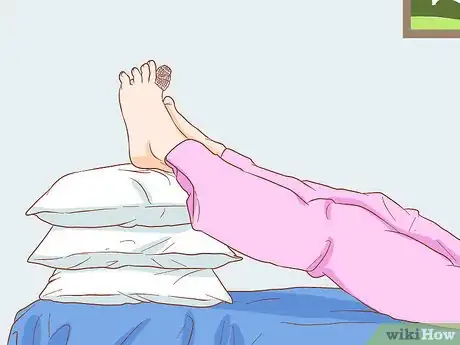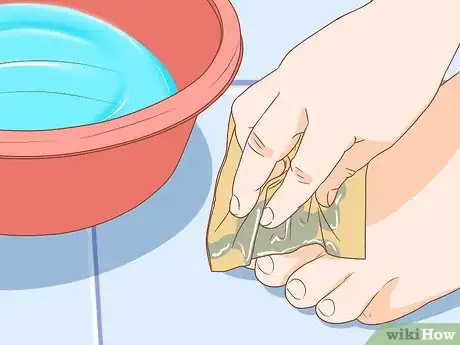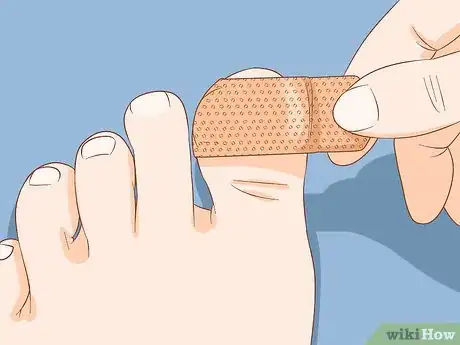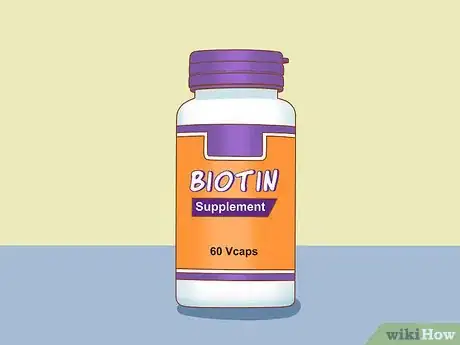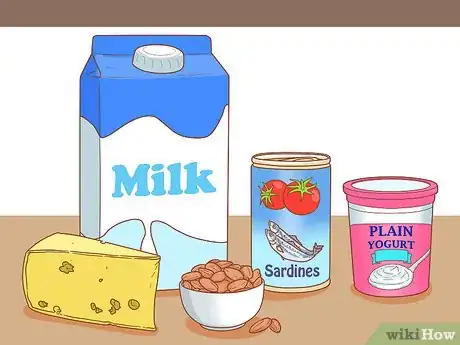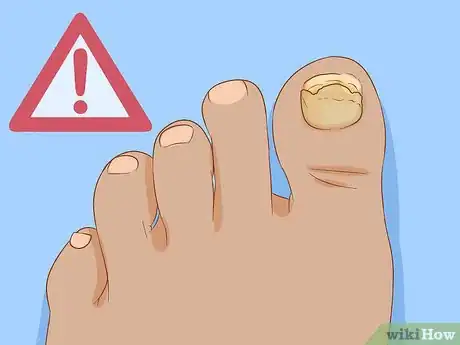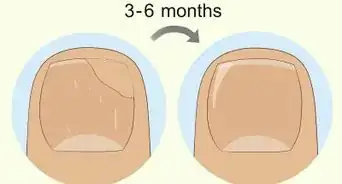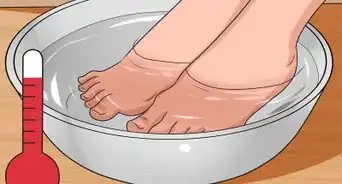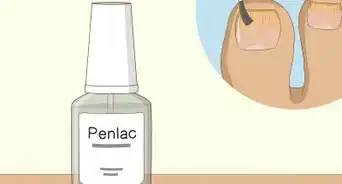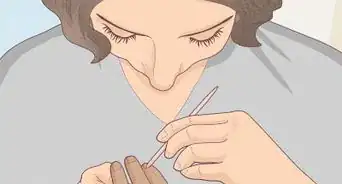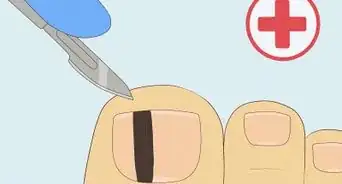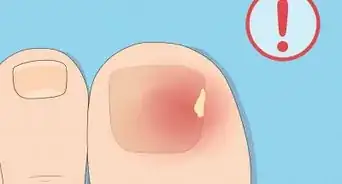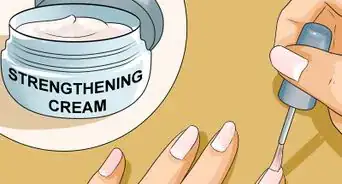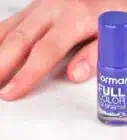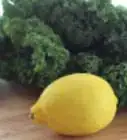This article was medically reviewed by Luba Lee, FNP-BC, MS and by wikiHow staff writer, Megaera Lorenz, PhD. Luba Lee, FNP-BC is a Board-Certified Family Nurse Practitioner (FNP) and educator in Tennessee with over a decade of clinical experience. Luba has certifications in Pediatric Advanced Life Support (PALS), Emergency Medicine, Advanced Cardiac Life Support (ACLS), Team Building, and Critical Care Nursing. She received her Master of Science in Nursing (MSN) from the University of Tennessee in 2006.
There are 11 references cited in this article, which can be found at the bottom of the page.
wikiHow marks an article as reader-approved once it receives enough positive feedback. This article received 21 testimonials and 91% of readers who voted found it helpful, earning it our reader-approved status.
This article has been viewed 1,167,001 times.
If you’ve lost a toenail, you probably want it to grow back as quickly as possible. While there’s only so much you can do to speed up the process, there are a few simple things you can do to help your nail regrow. As your nail heals, you'll need to protect the exposed nail bed by keeping it clean and moisturized. You can also soak your nail in a saltwater solution to moisturize the area and prevent infection. There is some evidence that biotin supplements and certain other vitamins can stimulate (or stabilize) hair and nail growth, so talk to your doctor about using supplements to support the healing process.
Steps
Protecting and Cleaning the Lost or Damaged Nail
-
1Trim away any sharp edges if your nail is torn. If part of your nail rips off, use nail scissors to carefully cut away the detached portion and trim any jagged edges. This will help prevent what’s left of the nail from snagging on things, which could cause further pain and injury.[1]
- After you trim your nail, rinse it in cool water for 20 minutes. Carefully pat the area dry with a clean towel and add a little petroleum jelly, then cover the injured nail with a bandage.[2]
Warning: If your nail is seriously damaged or comes off on its own for any reason, see your doctor. They can assess the problem and treat it appropriately to prevent any further damage.
-
2Follow your doctor’s home care instructions if you had the nail removed. If a doctor surgically removed your toenail, they will probably provide special instructions for caring for the nail after the surgery. Ask for a written care sheet that you can take home, and don’t hesitate to ask questions if you don’t understand the doctor’s instructions.Advertisement
-
3Keep the injured toe propped up for the first 3 days after losing the nail. After losing a nail, you will likely have some swelling and inflammation in the injured nail bed. To minimize these symptoms and promote faster healing, keep your foot propped up as much as possible during the first few days after the injury. Try to keep the toe above your heart level.
- For example, you might lie down on the couch with your foot propped up on the arm, or lie in bed with your foot on a couple of pillows.
- Rest the toe as much as possible. Avoid walking or putting weight on the toe if you can help it.
-
4Avoid getting your toe wet for the first 1-2 days after losing the nail. For the first 24-48 hours after losing your nail, keep the area dry as much as you can. If you have to shower, put a plastic bag over your foot to keep it from getting wet.
- This is especially important if you have stitches in your injured nail bed.
- If you have a bandage on your toe, change it if it gets wet.
-
5Wash your injured toe with clean water after the first 2 days. Once your toe has had 24-48 hours to rest and heal, you can start rinsing the area with clean, warm water. Gently wash the area twice a day.[3] This will help rinse away bacteria, dirt, and fibers from your clothing or bandages.
- You can also wash the area with mild soap, but take care not to use anything with harsh perfumes or dyes that might dry out and irritate the wound.
-
6Apply a little petroleum jelly to protect and moisturize your nail bed. Petroleum jelly can promote faster healing by keeping the wound moist and preventing scabbing.[4] Before bandaging your injured toe, gently apply a thin layer of petroleum jelly to the nail bed.
- Your doctor might also recommend using an antibiotic ointment on the injured nail bed.[5]
-
7Protect your nail with a bandage while it grows in. If the skin underneath your nail is exposed, put on a non-stick bandage. The bandage can help prevent infection, and it may keep the sensitive skin of your nail bed from rubbing painfully against socks and shoes.[6]
- Change your bandage daily, or whenever it gets wet or dirty. Whenever you change the bandage, wash your toe and apply a new layer of petroleum jelly.
- Keep wearing a bandage until your new nail grows in enough to mostly cover your nail bed.
- While the injury is fresh, avoid adhesive bandages or bandages made with fibrous materials that might stick to the wound (such as gauze). One good option it to use a silk bandage and hold it in place with a toe sock.[7]
-
8Wear shoes that fit well to avoid further injury. If you wear shoes that are too small (especially high heels), you can easily bruise your toenails and aggravate your injured nail bed. Your toes will only have a small space to move during a long period of time, which can slow the process of regrowing the nail.[8]
- Also refrain from making sudden stops. When you're done running, for instance, steadily slow to a walk so that you don't pitch forward, and your toes don't hit the tips of your shoes.
- Wear breathable cotton socks instead of tights or pantyhose.
- Your doctor may recommend wearing an orthopedic shoe for a while to protect your toe and give it a chance to heal.
-
9Be patient as your nail grows in. You may be able to somewhat speed your nail growth with soaks and vitamins, but you'll still need to wait for the nail to restore itself. It typically takes 12-18 months for a missing toenail to grow back, so don’t be concerned if your progress seems slow.
- While your nail is growing back, don’t disturb it or chip at it. It may be tempting to pull off unneeded bits of nail, but you shouldn't mess with it unless it's a hangnail or an ingrown toenail.
Using Soaks and Supplements to Promote Growth
-
1Soak the nail in warm saltwater 2-3 times a day to prevent infection. A saltwater soak can help clean your toe, kill bacteria, and promote healing. Make a solution of 1 teaspoon (about 5 g) of salt and 4 cups (0.95 L) of warm water and place it in a large bowl or shallow tub. Soak your toe in the solution for 20 minutes, 2-3 times daily.[9]
- This treatment is most effective during the first few days after you lose your toenail. You may need to wait 24-48 hours after the initial injury before you can safely do a soak, so ask your doctor for instructions.
- You can also make an Epsom salt soak using 2 teaspoons (10 g) of Epsom salts with 2 US quarts (1.9 L) of warm water.[10]
-
2Treat the nail with vitamin E ointment to encourage growth. Studies show that topical vitamin E solutions can improve the health of your nails and help them grow more quickly.[11] Once your new nail starts growing in, add a thin layer of vitamin E oil or ointment to the affected area each day.[12]
- If you’re using vitamin E oil as opposed to a cream or ointment, consider mixing it with a little petroleum jelly or a gentle moisturizer to prevent irritation and help hydrate the area.
- Wear open-toed shoes (or no shoes) for an hour after application, or until the oil has soaked into the skin. The effect will be stronger if you give your skin time to absorb the moisture.
-
3Try taking a biotin supplement. Hair and nails may grow more quickly when you take biotin as a dietary supplement. Indeed, weak and slow-growing nails are often linked to a biotin deficiency.[13] Talk to your doctor about using a biotin supplement to help your new nail come in strong and healthy.
- Always talk to your doctor before starting any new dietary supplement. Let them know about any other supplements or medications you are currently taking.
Tip: While it’s unclear whether biotin actually speeds up nail growth, it can likely strengthen your nails and keep them from becoming brittle.[14]
-
4Eat a diet rich in calcium and protein to promote better nail growth. While it probably won’t make a huge difference in how fast they grow in, eating a nutritious diet can help keep your nails strong and healthy. To help your missing nail heal as well as possible, try to eat plenty of the following:
- Calcium-rich foods, such as milk, cheese, yogurt, canned fish with bones (such as sardines), beans and lentils, almonds, and leafy greens.[15]
- Healthy sources of protein, such as poultry breast, fish, nuts, and dairy.
-
5Get a massage to promote better circulation in your feet. Sometimes poor circulation in your feet can inhibit healthy nail growth and make your nails weak. Consider going to a massage therapist or massaging your own feet at home using your hands or a foot roller.[16]
- Foot massage can be especially helpful if you have a condition like diabetes that interferes with circulation in your feet.
-
6Manage any health conditions that might affect your nail growth. If you have any underlying conditions that might make it harder for your nails to grow in properly, see your doctor to make sure they are being treated properly. There are many conditions that can weaken or damage your nails, including:
- Diabetes
- Psoriasis
- Toenail fungus
- Repetitive toe injuries (e.g., from running or playing sports)
Expert Q&A
-
QuestionIf I take one biotin pill every day and moisturize with olive oil, how long will it take my toenail to grow back?
 Luba Lee, FNP-BC, MSLuba Lee, FNP-BC is a Board-Certified Family Nurse Practitioner (FNP) and educator in Tennessee with over a decade of clinical experience. Luba has certifications in Pediatric Advanced Life Support (PALS), Emergency Medicine, Advanced Cardiac Life Support (ACLS), Team Building, and Critical Care Nursing. She received her Master of Science in Nursing (MSN) from the University of Tennessee in 2006.
Luba Lee, FNP-BC, MSLuba Lee, FNP-BC is a Board-Certified Family Nurse Practitioner (FNP) and educator in Tennessee with over a decade of clinical experience. Luba has certifications in Pediatric Advanced Life Support (PALS), Emergency Medicine, Advanced Cardiac Life Support (ACLS), Team Building, and Critical Care Nursing. She received her Master of Science in Nursing (MSN) from the University of Tennessee in 2006.
Board-Certified Family Nurse Practitioner Toenail re-growth can vary depending on your metabolism, immune system function, nutrition, hydration, and exercise. Support your body and keep your toenail clean and protected. You may apply olive oil or vaseline to speed up the regrowth.
Toenail re-growth can vary depending on your metabolism, immune system function, nutrition, hydration, and exercise. Support your body and keep your toenail clean and protected. You may apply olive oil or vaseline to speed up the regrowth.
Warnings
- See your doctor right away if you notice signs of infection, such as increasing redness, swelling, or pain in the nail bed, new bleeding or discharge from the wound, red streaks leading away from the injured toenail, fever, or swollen lymph nodes.⧼thumbs_response⧽
References
- ↑ https://www.drugs.com/cg/nail-avulsion-aftercare-instructions.html
- ↑ https://www.uwhealth.org/health/topic/special/torn-or-detached-nail/sig256776.html
- ↑ https://myhealth.alberta.ca/Health/aftercareinformation/pages/conditions.aspx?hwid=zp421
- ↑ https://www.aad.org/public/skin-hair-nails/injured-skin/wound-care
- ↑ https://www.stjude.org/treatment/patient-resources/caregiver-resources/patient-family-education-sheets/other-treatments/care-after-toenail-removal.html
- ↑ https://www.uwhealth.org/health/topic/special/torn-or-detached-nail/sig256776.html
- ↑ https://www.stjude.org/treatment/patient-resources/caregiver-resources/patient-family-education-sheets/other-treatments/care-after-toenail-removal.html
- ↑ https://www.drugs.com/cg/nail-avulsion-aftercare-instructions.html
- ↑ https://www.uwhealth.org/health/topic/special/torn-or-detached-nail/sig256776.html
- ↑ https://www.stjude.org/treatment/patient-resources/caregiver-resources/patient-family-education-sheets/other-treatments/care-after-toenail-removal.html
- ↑ https://www.ncbi.nlm.nih.gov/pubmed/2064401
- ↑ https://www.medicalnewstoday.com/articles/318168.php
- ↑ https://www.ncbi.nlm.nih.gov/pubmed/2273113
- ↑ https://www.ncbi.nlm.nih.gov/pmc/articles/PMC5582478/
- ↑ https://www.hmpgloballearningnetwork.com/site/podiatry/when-vitamin-and-nutritional-deficiencies-cause-skin-and-nail-changes
- ↑ https://www.health.harvard.edu/mind-and-mood/foot-massage-the-pause-that-refreshes-and-it-good-for-you
About This Article
To help a toenail grow back quickly, wash your foot regularly with soapy warm water to keep it clean and prevent any infection. Afterwards, try dabbing the nail with petroleum jelly or vitamin E oil to moisturize it, which prevents scabbing and promotes healing. You can also soak your foot in a bowl of warm saltwater for 15 minutes 2-3 times daily to soothe the skin and encourage nail growth. If the skin under your nail is exposed, put on a band aid during the day to prevent infection and be sure to replace it with a fresh bandage each day. You should also wear well-fitting shoes, since tight shoes, like high heels, will compress your toenails. For advice from our Medical co-author on how to encourage nail growth with supplements, read on!


